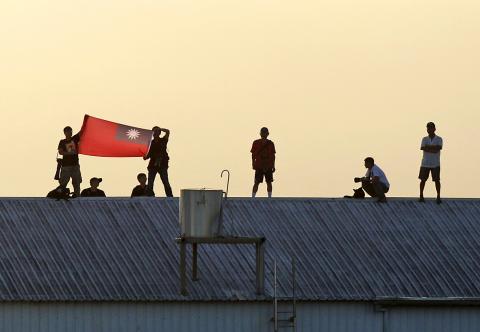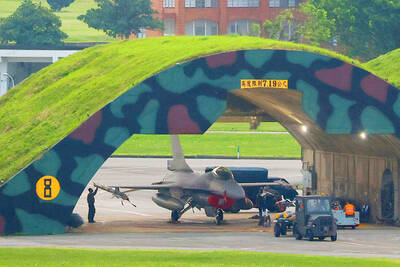The air force’s main combat aircraft, including F16 and Mirage jets, practiced emergency takeoffs and landings on sections of a freeway in the south yesterday as part of the military’s annual Han Kuang series of exercises that began on Monday.
An F-16 fighter jet, a Mirage 2000-5 and an Indigenous Defense Fighter (IDF) were used in the drill, landing shortly after 7am on the Minxiong (民雄) section of the Sun Yat-sen Freeway (National Freeway No. 1) in Chiayi County.
It was the first time the air force had one of its E-2K airborne early warning aircraft take part in the freeway practices.

Photo: Lin I-chang, Taipei Times
The E-2K, an all-weather early warning and control system platform equipped with radar and surveillance systems, has an extremely large wingspan which covers nearly the width of the freeway.
The E-2K pilot landed smoothly, gliding to the end of the temporary runway while folding up the craft’s large wings and moving to the designated area for resupply.
Other aircraft taking part in the drill included a CH-47 Chinook helicopter, an OH-58D reconnaissance helicopter and two AH-1W Super Cobra attack helicopters.

Photo: CNA
Yesterday’s exercise was to simulate an attack from China that destroys the air force base runways, requiring the military to rely on freeways as makeshift airstrips, an air force official said.
The Minxiong section is one of four sections of the nation’s main north-south freeway designated as emergency runways in the event of war.
The drill began with an F-16 landing on the freeway, followed by the IDF, the Mirage 2000-5 and the E-2K. Ground crews reloaded the aircraft’s ammunition bays and refueled the jets before they took off.

Photo: AFP
The F-16 was loaded with AIM-120 advanced medium-range air-to-air missiles, while the IDF and the Mirage fighter were loaded with AIM-9P4 Sidewinder missiles and MICA air-to-air missiles respectively, the air force said.
The twin-engine CH-47 Chinook, which was escorted by AH-1W Super Cobra helicopters, was used to deliver supplies.
Chief of General Staff Admiral Kao Kuang-chi (高廣圻) oversaw the exercise.

Photo: Reuters
The military coordinated with transportation agencies on the maintenance of the roadway before the drill, including repaving it to make sure it was flat, and familiarizing ground crews and pilots with the freeway, he said.
Colonel Shih Sheng-te (施勝德) of the air force’s 455th Tactical Fighter Wing said the Minxiong site presents pilots with several difficulties.
“Preparations were made beforehand to avoid bird collisions and intrusion of other objects. The area is also complicated by the presence of T-bars, power transmission towers and electricity grid lines. The Minxiong section is the most difficult among all the nation’s freeway emergency landing sections,” he said.
Another feature of yesterday’s drill was the use civilian aircraft to transport military personnel taking part in the exercises. Far Eastern Air Transport (遠東航空) and TransAsia Airways (復興航空), together with military C-130 planes, ferried one battalion of soldiers from an airport in Greater Kaohsiung to an air base in Penghu.
Meanwhile, two civilians trying to take photographs of the drill were injured after falling off a ladder as a CH-47 Chinook helicopter was delivering supplies for the fighter jets.
The strong vortex winds generated by the chopper’s rotors made it difficult for the pair to keep their balance, said Lieutenant General Wang Hsuan-chou (汪旋周), director-general of the air force’s Political Warfare Department.
“One man sustained an injury to his jaw and was discharged from Chiayi Christian Hospital after treatment, while the other man fractured his hand,” Wang said.
Yesterday’s drill was part of the second stage of the “Han Kuang 30” exercises, which are to run through Friday.

MISINFORMATION: The generated content tends to adopt China’s official stance, such as ‘Taiwan is currently governed by the Chinese central government,’ the NSB said Five China-developed artificial intelligence (AI) language models exhibit cybersecurity risks and content biases, an inspection conducted by the National Security Bureau (NSB) showed. The five AI tools are: DeepSeek, Doubao (豆包), Yiyan (文心一言), Tongyi (通義千問) and Yuanbao (騰訊元寶), the bureau said, advising people to remain vigilant to protect personal data privacy and corporate business secrets. The NSB said it, in accordance with the National Intelligence Services Act (國家情報工作法), has reviewed international cybersecurity reports and intelligence, and coordinated with the Ministry of Justice Investigation Bureau and the National Police Agency’s Criminal Investigation Bureau to conduct an inspection of China-made AI language

BOOST IN CONFIDENCE: The sale sends a clear message of support for Taiwan and dispels rumors that US President Donald Trump ‘sold out’ the nation, an expert said The US government on Thursday announced a possible sale to Taiwan of fighter jet parts, which was estimated to cost about US$330 million, in a move that an expert said “sends a clear message of support for Taiwan” amid fears that Washington might be wavering in its attitude toward Taipei. It was the first announcement of an arms sale to Taiwan since US President Donald Trump returned to the White House earlier this year. The proposed package includes non-standard components, spare and repair parts, consumables and accessories, as well repair and return support for the F-16, C-130 and Indigenous Defense Fighter aircraft,

CHECKING BOUNDARIES: China wants to disrupt solidarity among democracies and test their red lines, but it is instead pushing nations to become more united, an expert said The US Department of State on Friday expressed deep concern over a Chinese public security agency’s investigation into Legislator Puma Shen (沈伯洋) for “secession.” “China’s actions threaten free speech and erode norms that have underpinned the cross-strait ‘status quo’ for decades,” a US Department of State spokesperson said. The Chongqing Municipal Public Security Bureau late last month listed Shen as “wanted” and launched an investigation into alleged “secession-related” criminal activities, including his founding of the Kuma Academy, a civil defense organization that prepares people for an invasion by China. The spokesperson said that the US was “deeply concerned” about the bureau investigating Shen

LIMITS: While China increases military pressure on Taiwan and expands its use of cognitive warfare, it is unwilling to target tech supply chains, the report said US and Taiwan military officials have warned that the Chinese People’s Liberation Army (PLA) could implement a blockade within “a matter of hours” and need only “minimal conversion time” prior to an attack on Taiwan, a report released on Tuesday by the US Senate’s China Economic and Security Review Commission said. “While there is no indication that China is planning an imminent attack, the United States and its allies and partners can no longer assume that a Taiwan contingency is a distant possibility for which they would have ample time to prepare,” it said. The commission made the comments in its annual